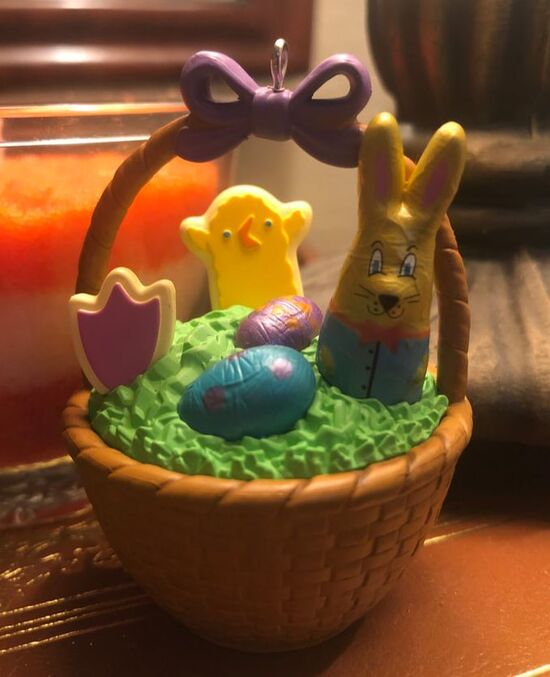|
Eastertide: Day 37 The ornament above, called Easter Sweets, was released last year by Hallmark, as part of the Season's Treating ornament series. It is hanging in my kitchen, near some of my other Easter decorations. Although I grew up getting an Easter basket, and I created and gave (actually still give :) ) Easter baskets to my kids, this ornament made me stop and wonder - just where does the tradition of giving Easter baskets come from? I have always just vaguely assumed that the candy, jelly beans and obligatory chocolate bunny were basically signs of the sweetness and joy of Easter. It is right and proper for us to celebrate Easter Sunday as being different from all other days, and so one way we do that is through these once-a-year baskets. But, it turns out there's a little more to it than that. Quite a bit more, in fact. After a little digging, I found that the tradition of giving these Easter baskets is connected to a deeper Catholic custom of blessing, and specifically, the blessing of "the Easter basket." In the days before the coming of Christ, there were many customs around celebrating the Spring Equinox, the time when the days began to grow longer as the cold, dark winter days slowly waned into the warmth of summer. Venerable Bede, a well-known English monk and scholar who is still often quoted today, wrote about festivals to the Anglo-Saxon goddess, Eostre, who was often depicted carrying a basket full of spring bounty. In fact, her name in early Germanic translates to "Dawn." When she appeared, she ushered in health, life and vitality. Since rabbits and eggs are typical symbols of new life, they were also often shown in her basket or around her, on the new spring grass. After Christ's death and resurrection, however, his new disciples transferred the egg symbolism to the new life found in Christ. The symbol of the egg was also used in Judea, and, in fact, there is a famous icon of Mary Magdalene, holding a red egg, which represents the blood of Christ shed for us, thereby resulting in new life. When the egg is cracked open, it reminds us of the empty tomb. (This is also the tradition behind the Mexican cascarones.) But the church did more than just sing songs in the forest. By the early Middle Ages, it was an Easter custom to bring the baskets into church, where they received a special Easter blessing. In the early days, the baskets were not so much about candy and chocolate. Instead, they usually contained the food that would be used to make the Easter dinner. This custom continues today. In Catholic churches around the world, families are invited to bring in their Easter baskets on Holy Saturday, to be blessed. There are special foods that are typically placed in the baskets and these change somewhat depending on the traditions of each family. An Easter Blessing for Baskets As Christianity became more widespread, however, the contents of the basket changed from meal-type foods to the baskets filled with candies, chocolate and even toys that we know today. But even if the baskets are now filled with chocolate, the meaning of the symbols remains the same: we rejoice at Easter because of the saving action of Jesus. His death and resurrection brings us new life, represented by bunnies, chicks, eggs and even soft, new grass. For more information about a traditional Easter basket, go to this link: Holy Cross Catholic Church
0 Comments
Leave a Reply. |
The BlogDisclaimer:
The images on this website are either my own or are used under the Creative Commons license. No images have been edited, shared, or adapted. A link to each work that I do not own is provided at the bottom of the page. CC License: Archives
March 2024
Categories
All
|





 RSS Feed
RSS Feed
